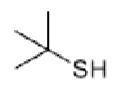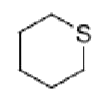0.102 g of an organic compound X was oxidized with fuming nitric acid. The resulting solution, after reaction with an excess of aqueous BaCl2 produced 0.233 g of BaSO4 as a precipitate , compound X is likely to be :
[Given : Atomic wt. of Ba = 137]




To solve the problem, we need to determine the organic compound X based on the information provided about its oxidation with fuming nitric acid and the subsequent formation of barium sulfate (BaSO₄) when reacted with barium chloride (BaCl₂).
1. Identify the mass of BaSO₄ produced:
We are given that 0.233 g of BaSO₄ is formed as a precipitate.
2. Calculate the moles of BaSO₄:
The molar mass of BaSO₄ can be calculated as follows:
- Atomic mass of Ba = 137 g/mol
- Atomic mass of S = 32 g/mol
- Atomic mass of O = 16 g/mol (4 oxygen atoms)
- Molar mass of BaSO₄ = 137 + 32 + (4 × 16) = 233 g/mol
Now, we can calculate the moles of BaSO₄:
Moles of BaSO₄=massmolar mass=0.233 g233 g/mol=0.001 moles
3. Relate moles of BaSO₄ to moles of sulfate (SO₄²⁻):
From the reaction, we know that 1 mole of BaSO₄ is produced from 1 mole of sulfate ions. Therefore, the moles of sulfate produced are also 0.001 moles.
4. Determine the molar mass of the organic compound X:
The organic compound X is oxidized to produce sulfate ions. We can use the relationship:
mass of compound X=moles of sulfate×molar mass of compound X
Given that the mass of compound X is 0.102 g and the moles of sulfate are 0.001 moles:
0.102 g=0.001 moles×molar mass of compound X
Rearranging gives us:
molar mass of compound X=0.102 g0.001 moles=102 g/mol
5. Identify the compound with a molar mass of 102 g/mol:
We need to check the options provided to find which organic compound has a molar mass close to 102 g/mol. Based on the given options, we find that option D has a molar mass of 102 g/mol.
6. Conclusion:
The organic compound X is likely to be the one with a molar mass of 102 g/mol, which corresponds to option D.
Final Answer:
The organic compound X is likely to be option D.
We are given that 0.233 g of BaSO₄ is formed as a precipitate.
The molar mass of BaSO₄ can be calculated as follows:
- Atomic mass of Ba = 137 g/mol
- Atomic mass of S = 32 g/mol
- Atomic mass of O = 16 g/mol (4 oxygen atoms)
- Molar mass of BaSO₄ = 137 + 32 + (4 × 16) = 233 g/mol
Moles of BaSO₄=massmolar mass=0.233 g233 g/mol=0.001 moles
From the reaction, we know that 1 mole of BaSO₄ is produced from 1 mole of sulfate ions. Therefore, the moles of sulfate produced are also 0.001 moles.
The organic compound X is oxidized to produce sulfate ions. We can use the relationship:
mass of compound X=moles of sulfate×molar mass of compound X
Given that the mass of compound X is 0.102 g and the moles of sulfate are 0.001 moles:
0.102 g=0.001 moles×molar mass of compound X
Rearranging gives us:
molar mass of compound X=0.102 g0.001 moles=102 g/mol
We need to check the options provided to find which organic compound has a molar mass close to 102 g/mol. Based on the given options, we find that option D has a molar mass of 102 g/mol.
The organic compound X is likely to be the one with a molar mass of 102 g/mol, which corresponds to option D.
The organic compound X is likely to be option D.
Topper's Solved these Questions
- BOOK - KVPY PREVIOUS YEARCHAPTER - KVPY 2021EXERCISE - PART-I Chemistry20videos
KVPY 2021
- BOOK - KVPY PREVIOUS YEARCHAPTER - KVPY 2021EXERCISE - PART II CHEMISTRY10videos
KVPY 2021
- BOOK - KVPY PREVIOUS YEARCHAPTER - KVPY 2021EXERCISE - PART II CHEMISTRY10videos
KVPY 2021
- BOOK - KVPY PREVIOUS YEARCHAPTER - KVPYEXERCISE - exercise14videos
KVPY
- BOOK - KVPY PREVIOUS YEARCHAPTER - MOCK TEST 1EXERCISE - EXERCISE29videos
MOCK TEST 1
Similar Questions
0.1570 g of an organic compound was heated with fuming nitric acid in carius tube. Addition of excess of barium chloride yielded 0.4813 g of barium sulphate as a white precipitate. Determine the percentage of sulphur in the compound.
View Solution1.6 g of an organic compound containing sulphur, when series of reagents ,produces H2SO4 which on reaction with BaCl2 produces 0.233 g of BaSO4. Calculate % by mass Of S in the orgnic compound . (Given : Atomic weight of Ba = 137 )
View Solution
Knowledge Check
- Question 1 - Select One
0.99 g of an organic compound containing halogen when heated with fuming nitric acid in the presence of silver nitrate in a carius tube gave 0.287 g of white precipitate. The percentage of halogen in the compound is about
A29.6B71.7C35.4D64.2 - Question 2 - Select One
If 0.32g of an organic compound containing sulphur produces 0.233g of BaSO4, the percentage of sulphur in the compound is
A15B10C20D25 - Question 3 - Select One
If 0.32 g of an organic compound containing sulphur produces 0.233 g of BaSO4 Then the percentage of sulphur in it is
A10B15C20D25
1.09g of an organic compound on heating with fuming nitric acid followed by addition of AgNO3 ,give 0.1422g AgCl .The percentage of chlorine in the compound is
View Solution1.09g of an organic compound on heating with fuming nitric acid followed by addition of AgNO3 ,give 0.1422g AgCl .The percentage of chlorine in the compound is
View SolutionAn organic compound 'A' is oxidized with Na2O2 followed by boiling with HNO3. The resultant solution is then treated with ammonium molybdate to yield a yellow precipitate. Based on above observation,the element present in the given compound is :
View SolutionIf 0.32 g of an organic compound containing sulphur produces 0.233 g of BaSO4 Then the percentage of sulphur in it is
View Solution2.18g of an organic compound containing sulphur produces 1.02 g of BaSO4. The percentage of sulphur in the compound is
View Solution

